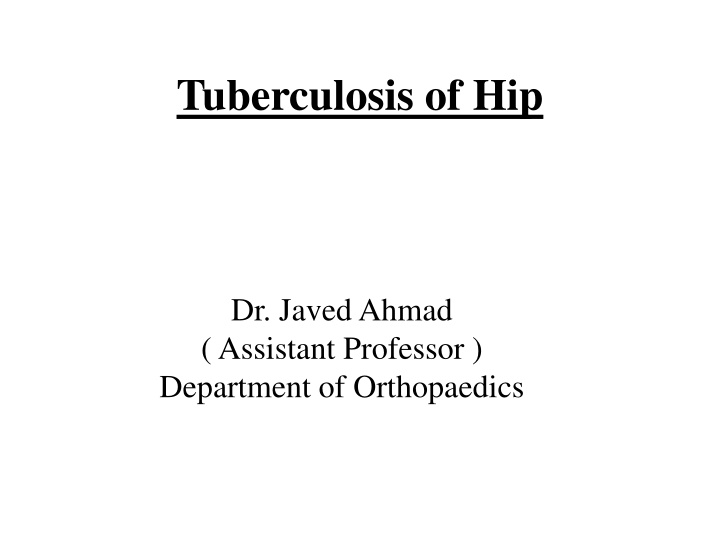
Tuberculosis of Hip: Causes, Symptoms, and Treatment Overview
Learn about tuberculosis of the hip, including causes, symptoms, and treatment options. Discover how Mycobacterium tuberculosis affects joints and bones, leading to osteoarticular TB. Explore the pathogenesis, common sites of infection, and granuloma formation in this informative guide.
Download Presentation

Please find below an Image/Link to download the presentation.
The content on the website is provided AS IS for your information and personal use only. It may not be sold, licensed, or shared on other websites without obtaining consent from the author. If you encounter any issues during the download, it is possible that the publisher has removed the file from their server.
You are allowed to download the files provided on this website for personal or commercial use, subject to the condition that they are used lawfully. All files are the property of their respective owners.
The content on the website is provided AS IS for your information and personal use only. It may not be sold, licensed, or shared on other websites without obtaining consent from the author.
E N D
Presentation Transcript
Tuberculosis of Hip Dr. Javed Ahmad ( Assistant Professor ) Department of Orthopaedics
ROBERT KOCH discovered Mycobacterium tuberculosis in1882
CAUSATIVEORGANISM MYCOBACTERIUM TUBERCULOSIS M/C HUMAN PATHOGEN SIZE 3X.3UM GRAM POSITIVE AFB HEMATOGENOUS DISSEMINATION FROM PRIMARY FOCUS BONE AND JOINTS TB DEVELOP GENERALLY 2-3 YRS AFTER PRIMARY FOCUS
M.tuberculosis - rodshaped,gram positive nonsporeforming, thinAEROBICbacilli 0.5 m 3 m Organism.. Once stained ,the bacilli cannot be decolorised by acid alcohol-thus called ACID F ASTBACILLI Acid fastness is due to high content of MYCOLIC ACIDS,long chain cross linked fatty acids,other cellwalllipids
Pathogenesis &Pathology Primary focus (Active/quiscent,Apparent/latent) Hematogenous dissemination 2-3yrs Osteoarticular TB
Organism reaches joint space through either 1. Subsynovialvessels 2. Lesions in the epiphysealbones Articular cartilage destruction begins peripherally TB Arthritis-doesnot form proteolytic enzymes in jointspace articular cartilage preserved for longtime central areas of
Commonsites.. Initial focus may start in 1. Acetabular roof m/c 2. Epiphysis/FemurHead 3. Metaphysealregion 4. Greater trochanter- leastcommon
TB of GT may involve the overlying trochanteric bursa witout involving the hip joint for a very longtime Upper end of femur intracapsular joint involvedrapidly When initial focus starts in acetabular roof- joint involvement is late ,symptomsmild
Tubercle/Granulomaformation... Initial stages of infection-usually asymptomatic 2-4wks after infection-2 host responses 1.Macrophage activated CMI: T-cellmediated response Activation ofmacrophages Killing & digesting tubercle bacilli 2.Tissue damagingresponse various bacillaryantigens - Destroys unactivated macrophages that contain multiplyingbacilli
Insemination ofinfection Accumulation ofmacrophages/monocytes TB bacilli phagocytosed,broken down Lipid dispersed throughout the cytoplasm EPITHELOID cells large pale cells large vesicular nuclues Abundantcytoplasm LANGHANS GAINTcells
Mass formed by reactive cells - Nodule/TUBERCLE 2wks central CASEOUSNECROSIS Presence of caseous necrosis SOFTTUBERCLE Nocaseousnecrosis HARDTUBERCLE
ColdAbscess Collection of products of liquefaction & reactiveexudation Contains - serum, leukocytes, caseousmaterial, bone debris,TBbacilli Feels warm ,but temperature not raised as high as in acute pyogenicinfection Bursts Sinus/ulcerformation
Cold abscess forms within the joint inferior weaker part of thecapsule Perforated Cold abscess presents anywhere around the hip femoraltriangle Medial,lateral/ posterior aspect of thigh Ishcio rectalfossa Pelvis
Intra pelvicabscess Belowthe levatorani Above levatorani Upwards into inguinalregion Ischiorectalfossa
Types ofDisease CASEOUSEXUDA TIVE Moredestruction More exudation& abscess formation Insidiousonset Marked constitutional features GRANULAR Lessdestruction Abscess formation rare Insidious onset & course DRYlesion
Fate oftubercle Resolvecompletely Heal completely with residual deformities/ loss of function Lesion completely walled off,caseous tissue calcified Low grade chronic fibromatous, granulating & caseating lesion maypersist Infection spreads contiguous,systemically
Clinical features.. Commonest age : 1st 3 decades Limping earliest,commonestsymptom -Antalgicgait Pain reffered to medial aspect of knee - max towards end of the day Deformity Fullness around the hip Nightcries sleepawakening
Synovitisstage.. Position of max joint capacity F ABER ApparentLENTHENING Only extremes of movement are painful D/D Traumaticsynovitis -NonspecificTransient Synovitis -Low grade pyogenic infection -Perthesdisease -SCFE X-Rays: soft tissuesweling,Rarefaction
Early Arthritisstage.. Articular damagestarts Severe muscle spasm-FADIR Apparentshortening Restriction of movements in alldirections Appreciable musclewasting MRI synovialeffusion - minimal ares of bonedestruction - osseousoedema X-Rays: OSTEOPENIA, marginal bony erosions NORMAL JOINTSP ACE
Advanced Arthritis.. FADIR Trueshortening severity of symptoms Capsule further dstroyed ,thickened & contracted X-Rays : Destruction of articularsurface Jointspace
Advanced arthritis with Subluxation / Dislocation With further destruction of acetabulum, femur head ,capsule & ligaments the upper end of femur is displaced upwards & dorsally in the wandering / migrating acetabulum leaving its lower part empty& broken Pathological dislocation of femurhead Movements are grosslyrestricted
Classification -Radiologicalappearence Shanmugasundaram in 1983 classified the radiological appearencesas 1. Type1- normal(C) 2. Type 2 Travelling/ wandering acetabulum(C,A) 3. Type 3 Dislocatingtype(C) 4. Type 4 Perthes type(C) 5. Type 5 Protrusio acetabuli(C,A) 6. Type 6 Atrophic(A) 7. Type 7 Mortar & Pestletype(C,A)
PROTRUSIOTYPE A TROPHICTYPE
If the disease occurs duringchilhood 1. Chronichyperaemia & metaphysis 2. Thrombo embolic phenomenon of selective terminal vasculature PERTHESdisease 3. a)Gross blood supply of femoral head due to TE b) Rapidly developing tense IC effusion (Tamponadeeffect) reduced femoral head & necksize Enlarged femoral head epi COXAMAGNA changes similar to COXABREV A
Restricted growth of epiphyseal plate & normal trochantericgrowthplate COXAV ARA Restricted trochanteric growth & normal femoralhead COXAV ALGA
Close relationship b/w radiological type & therapeuticoutcome: 1. Normaltype 2. Perthestype - 80% goodresults 3. Dislocating type 50% goodresults 4. Travellingacetabulum & Mortar pestletype - 29% goodresults - 92% goodresults
Evaluation Hematological ESR,relativelymphocytosis Bacteriological AFB staining &C/S Serological ELISA serumIgG,IgM Histology HPE for TUBERCLE Molecular PCR Clinico radiological : X-Rays, CT Scan MRI USG
Synovial fluid aspiration AFB positive in 10 20% of cases Cultures positive in 50% of cases Aspiration of cold abscess formicrobiology Synovial Biopsy Morereliable Cultures positive in 80%cases Histology : granulomatousinflammation
Bacteriologicaldiagnosis.. Specimen stained for AFB &C/S Stains used: - ZIEHL NEELSENstain -Auramine Orangefluorescence Media used for growth: Lowenstein-Jensen Conventional AFB C/S 4wks -requires liveorganism -long incubationperiod -low sensitivity in pts already onA TT Newer rapid culture tech-BACTEC
BACTEC : Radiometric culturesystem - Detects Mycobac as early as 7-14 days - BasedonreleaseofradiolabelledCO2from the growth of Mycobac in selective LIQUID mediausingC14 labelled substrate
Serology.. IgM diagnostic of activity of thedisease IgG diagnostic of chronic disease/healed disease - levels remain high even after fullRx ELISA antibody values are dependenton -time of takingsample -state / phase of the disease Antibody titres donot correlate withrecovery status of thepatient.
Moleculardiagnosis.. PCR single test which amplifies the genome even if a single organism waspresent Ideal for detection of paucibacillary TBcase Many target genes of Mycobacteria 16sr RNA used as target sequence as it is universallypresent - genus specificmarker falsenegative
Advantages ofPCR.. 1. Highly efficient & rapid method for Dx 3days 2. Great value in early Dx 3. Very sensitive tech could detect as few as 1-2 mycobac in the specimen , and Rx initiated based on this result if clinical signs of disease present 4. Can differentiate typical from atypicalmycobac 5. Requires very small quantity of specimen even microlitres of FN aspirate can be tested
Disadvantages.. Notable to differentiate live from deadorg, as it is not dependent on bacreplication Doesnot tell about the activity of thedisease PCR positive results doesnot always confirm to cultureresults PCR not a substitute forculture
Culture goldstandard CT guided FNAC useful & minimally invasive method of ascertaining HPDx Screening tests: 1. Tuberculin skin test/Mantoux test 2. Interferon gamma release assay(IGRA)
Radiological.. X-Rays USG CT Scan MRI
Management.. Early diagnosis , effective chemotherapy vital to save the joint Depends upon the stage of clinical presentation Rx includes :A TT Absolute bed rest Traction Excision Arthroplasty Arthrodesis THA
T raction.. Prevents /Corrects the deformity Rest to thepart Relieves musclespasm Maintains jointspace Minimises development of migration of acetabulum - B/L traction if abduction deformity,to stabilise thepelvis
After 4-6 months of Rx Ambulation with crutches / orthosis Ambulation: - 1st 12 wks non weightbearing - 2nd 12 wks partial weightbearing Unprotected wt bearing 18-24 monthsafter onset ofRx
MDR TB MDR TB : BacteriologicalDx - If the infecting organism is resistantto 1. INH 2. Rifampicin with/without resistanceto otherA TT XDR-TB : MDR TB strains resistant to FLUOROQUINOLONES & one of the Injectables Kanamycin,Amikacin,
Resistant /therapeutically refractory case : In clincal orthopedics 1. No response to A TT / No progressivehealing 2. Destructive process 3. Continuing discharging sinuses , ulcers 4. New cold abscessapearence 5. size of existing coldabsces
Rx Synovitisstage Chemotherapy A TT Bedrest Traction Mobilisationexercises prognosis verygood Surgical intervention usually notrequired
Rx EarlyArthritis Chemotherapy A TT Traction Analgesicssupplementation Non wt bearing ROM exercises started as permitted Synovectomy & jointdebridement Passive exercise avoided Prognosis in general - good pain,spasm . Thus
Rx AdvancedArthritis All above& ARTHROL YSIS subtotal excision of pathological contracted fibrouscapsule - Useful where limitation of movements is due to FIBROUSANKYLOSIS - Aim T o achieve usefulROM - Posterior capsule undisturbed vital blood supply
Rx Advanced arthritis with subluxation / dislocation Conservative tractionregimen If sound ankylosis ,in bad position upper femoral correctiveosteotomy Excisionarthroplasty Arthrodesis Hipreplacement

